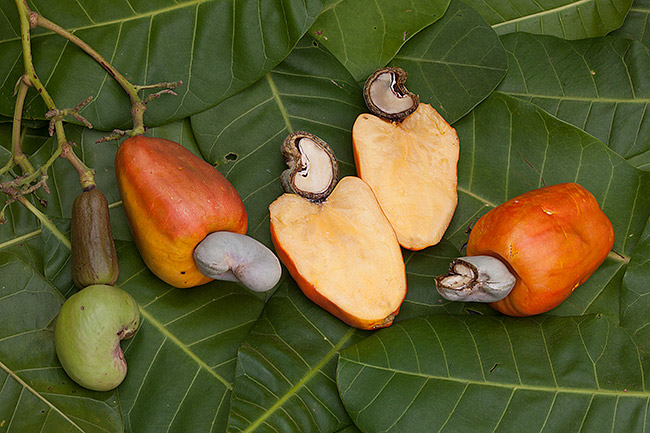
The edible cashew “apple” an aril is the largest part of the fruit.

Cashews are high in potassium.
The Cashew belongs to a rather toxic group of plants, all closely related and some of which we eat: Poison Ivy, Poison Sumac, Mangos, Brazilian Pepper, Pistachios, and Cashews. While the cooked cashew “apple” and roasted nut are edible the shell’s jell is extremely toxic. Mother Nature does not want you eating those nuts and protects them mightily. Not surprisingly the tree itself looks mango-ish. Many people get a poison ivy like rash from touching mangos. They can, however, usually eat mango if someone else peels it. Like the Ginkgo tree, if you don’t clean up Cashew debris it can leave a toxic litter. We used to visit one often in my foraging classes until Hurricane Irma destroyed it.

Nature protects the nut with a caustic brown jell.
The Cashew apple, which can be eaten raw but is safer processed, has per 100 grams 124 mg of potassium, 67 mg of phosphorus, 10 mg calcium, 49 mg vitamin C, 2 mg iron, 3.2 mg fiber, 53 calories and 23 mcg beta-carotene. The unsalted cashew nut contains 583 calories, 14.85 grams of protein, 47.96 grams fat, 31.71 grams total carbohydrate, 2.9 grams fiber, 548 mg potassium, phosphorus 475 mg, magnesium 252 mg, calcium 44 mg, sodium 16 mg, iron 5.82 mg, zinc 5.43 mg, copper 2.153 mg, selenium 11.3 mcg B1 (thiamine) and B2 (riboflavin) 0.194 mg each, B3 (niacin) 1.358 mg, B6 (pyridoxine) 0.248 mg, B9 (folate) 67 mg, choline 59.2 mg, Vitamin E 1.24 mg, Lutein+zeaxanthin 22 mcg, vitamin K 37.2 mcg and in a separate study 7 mg ascorbic acid.

Raw cashews are extremely toxic topically.
Cashew trees are planted for three reasons: They look attractive– make a good shade tree if you clean up under them — and produce edible parts (with proper preparation.) The tree, which is native to northern Brazil, has large leaves and pretty pink blossoms. Like the Podocarpus there is an aril then a seed on the end. The cashew “apple” is a swollen part of the stem rather than the ovary. It can be yellow to red, is high in vitamin C, juicy and slightly acidic. Rather than eaten out of hand — the “apple” can make the mouth feel fuzzy — it is often used with other fruits and juices via blending. The nut is in a kidney-shaped double shell with a caustic brown liquid between the outer shell and the inner testa that will quickly burn your skin or mouth. The cleaned nut is edible raw but roasted is better and that can reduce allergic responses. Eating them raw is dangerous and difficult because of the caustic chemicals and allergies to the parts that are processed away. After drying the unshelled seeds are soaked for a few days in water. The seed is cooked in oil (210 C) for two minutes then cooled in water. Then they are shelled, dried, and the papery coating — the testa — is removed. The shells with nuts inside can also be fried in an open pan but that is more iffy in that the shells can squirt the bad jell. The smoke is also toxic, don’t breath it in. Another method for the brave is to freeze the shell/nut and shell it while frozen peeling away the acidic jell. Wear heavy gloves and goggles. Work fast. Know that cashew production is the source of questionable labor practices where they are produced.

Cashews have a burning liquid between the nut and the shell.
Young cashew shoots can be eaten and the “apple” cut in to pieces, blanched, dried, then cooked like a vegetable. In fact it is far more popular where they grow than the nuts. The “apples” also dry well and can be made into jam or wine. They can also be feed to livestock — minus the seed. The “apple” contains five times more vitamin C than an orange and more calcium, iron, and B1 than bananas, avocados or citrus. They are also a good source of magnesium, phosphorus and copper. Cashews bloom in winter so you have to have a warm winter.
Botanically the tree is Anacardium occidentale, Anacardium is Greek with a Latin ending that means heart-shaped — referring to the shape of the aril. Occidentale means western (usually European.) Native to tropical America from Mexico and the West Indies to Brazil and Peru. It has few pests or diseases.
Green Deane’s Itemized Plant Profile
IDENTIFICATION:Spreading evergreen perennial tree to fifteen tall; leaves simple, alternate, obovate, hairless to eight long, six inches wide, pointed or notched, not teeth, short petiolate; flowers numerous in terminal panicles, six to eight long, male or female, green and reddish. The cashew-apple is shiny, red or yellowish, pear-shaped, soft, juicy, six to eight inches long, two to four inches wide; seed surrounded by a hard shell oily, said oil is poisonous causing allergenic reactions in some.
TIME OF YEAR: Fruits in wet weather, three months from flower to fruit.
ENVIRONMENT: Grows in almost any soil but does not tolerate salt or frost.
METHOD OF PREPARATION: Apple edible raw better cooked, seeds processed.


I read at http://www.naturalmedicinalherbs.net/herbs/p/populus-deltoides=eastern-cottonwood.php that Cottonwood is rich in protein. All the foraging books and better know websites ignore this. Why?
Hi, thank you for the information. If you could make your wonderful articles print-friendly that would save paper. What would you recommend for parasites and Lyme?.
It is possible to get truly raw cashews, if interested. I have bought them from this seller for many years. And, by the way, the USDA allows U.S. almonds to be labeled “raw” when they have been pasteurized (and are NOT raw). You can however buy RAW almonds directly from growers in the U.S, buy from other sellers of RAW almonds, or buy imported almonds that are RAW. Cheers. Here is his website….www.matt-monarch.com